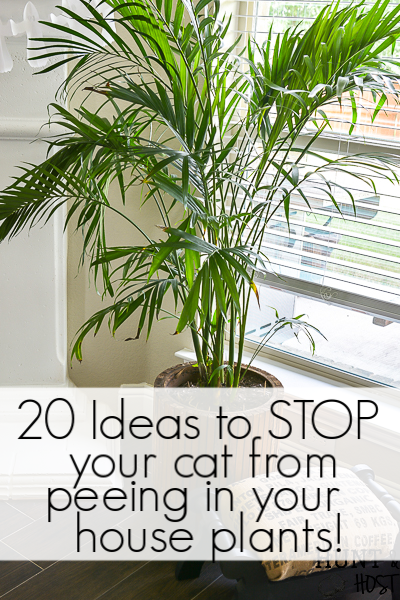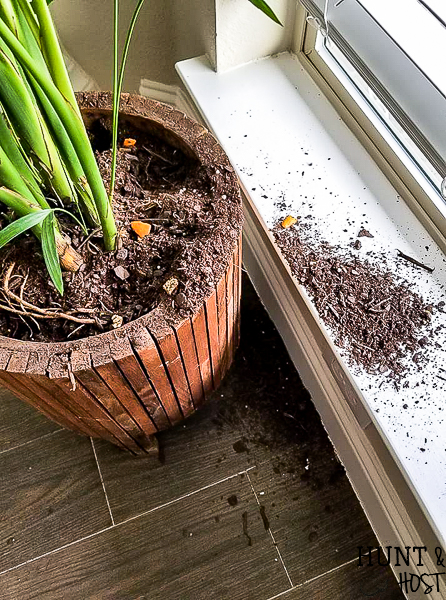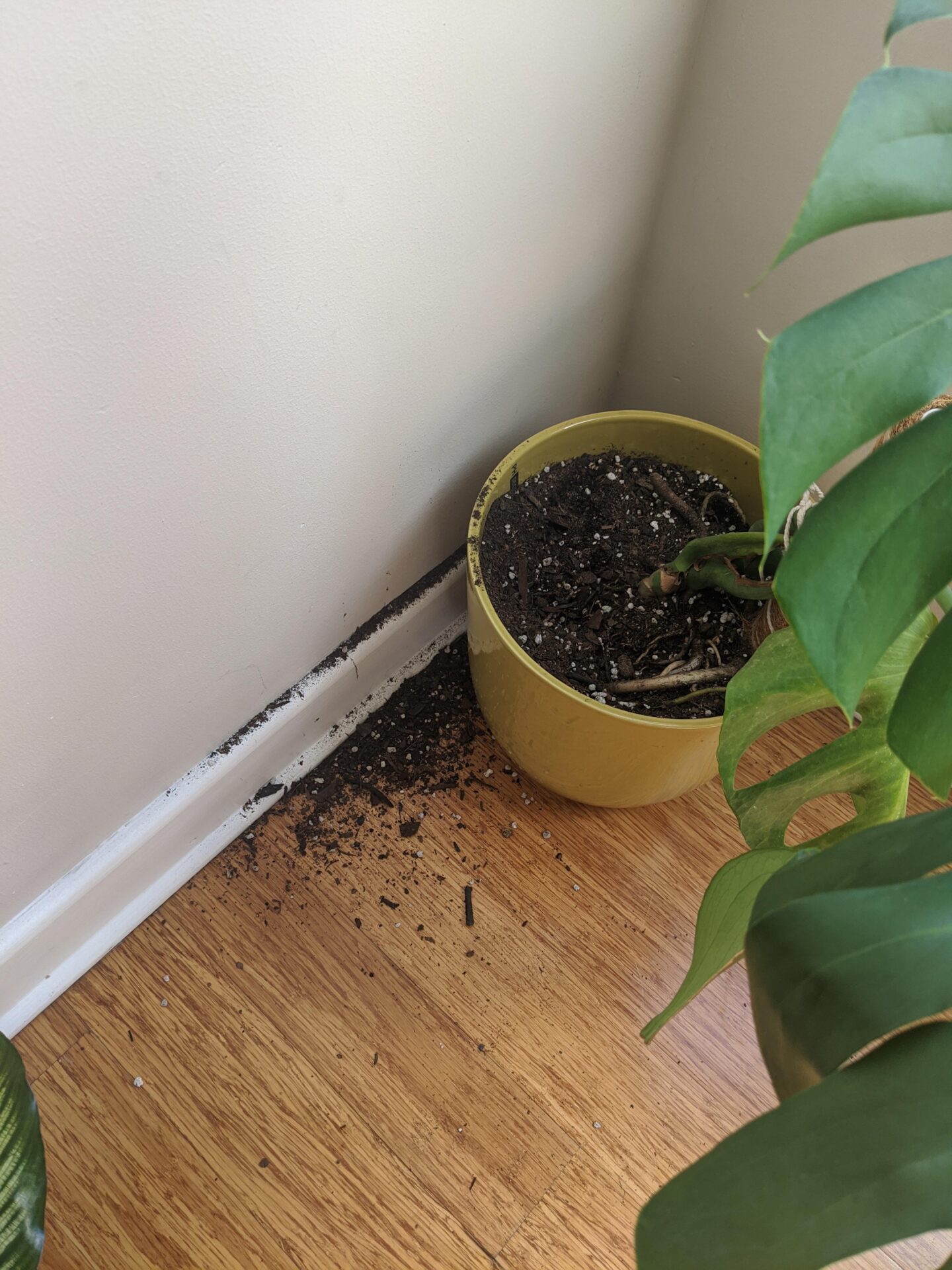Remove the soiled soil and replace it with fresh soil. Use a deterrent spray to prevent your cat from returning.
Cats often see houseplants as a convenient place to relieve themselves. This can be frustrating for plant owners. Cat urine can damage the plant and create an unpleasant odor. Thankfully, there are effective solutions to stop this behavior. By understanding why cats choose to pee in houseplants, you can take steps to discourage it.
This includes removing the contaminated soil and using deterrent sprays. Training your cat to use the litter box consistently is also crucial. Simple changes can protect your plants and keep your home smelling fresh. With these tips, you can maintain a harmonious environment for both your plants and your furry friend.

Credit: www.reddit.com
Identify The Problem
Has your cat turned your house plant into a personal litter box? This behavior can be frustrating and damaging to your plants. Understanding why this happens is the first step to solving the issue.
Signs Your Cat Is Peeing In Plants
- Wilting or yellowing leaves: Cat urine is toxic to plants.
- Strong ammonia smell: Urine has a distinct odor.
- Wet soil or unusual damp spots: Check the soil for wet patches.
- Cat frequently near the plant: Watch your cat’s behavior around plants.
Common Reasons For This Behavior
| Reason | Description |
|---|---|
| Territorial Marking | Cats use urine to mark territory. |
| Litter Box Issues | Dirty or unavailable litter boxes push cats to find alternatives. |
| Stress or Anxiety | Changes in environment can cause stress. |
| Curiosity | Cats may explore plants out of boredom. |
Identifying the root cause of your cat’s behavior is crucial. This will guide you in finding an effective solution. Stay observant and patient for the best results.
Immediate Actions
Discovering that your cat has peed in your house plant can be frustrating. Immediate actions are crucial to prevent further damage and eliminate odors. Address the issue quickly to maintain a clean and pleasant home environment.
Clean The Affected Area
Start by removing the cat urine from the plant soil. Use gloves to scoop out the soiled soil. Replace it with fresh soil to ensure the plant’s health. If the leaves are affected, gently wipe them with a damp cloth.
For pots, rinse them thoroughly with water. If possible, use a mild soap solution for a deeper clean. Ensure no soap residues remain, as they can harm the plant.
Neutralize Odors
Odor neutralization is vital to discourage your cat from peeing in the plant again. Use a mixture of water and vinegar to clean the affected area. Spray the solution on the plant soil and pot, then let it sit for a few minutes.
Rinse the area with clean water afterward. You can also use a commercial enzyme cleaner designed for pet urine. These cleaners break down the urine molecules, effectively neutralizing the odor.
| Action | Materials Needed |
|---|---|
| Remove Soiled Soil | Gloves, Fresh Soil |
| Clean Plant Leaves | Damp Cloth |
| Rinse Pot | Water, Mild Soap |
| Neutralize Odor | Water, Vinegar, Enzyme Cleaner |
Following these steps ensures your plant remains healthy and your home stays fresh. Quick actions prevent further issues and maintain a pleasant living space.
Preventive Measures
Keeping your cat from peeing in your house plants can be a challenge. Cats are curious and sometimes see plants as their personal litter boxes. Here are some effective preventive measures to protect your plants.
Use Deterrents
Deterrents can help keep cats away from your plants. Use natural sprays or repellents. Citrus scents like lemon or orange work well. Cats dislike these smells.
You can also try vinegar. Mix vinegar with water and spray it on the soil. It is safe for plants but cats hate the smell.
Another option is commercial cat repellents. These are available in pet stores. Follow the instructions on the package for best results.
Cover The Soil
Covering the soil can also prevent cats from peeing in it. Use stones or rocks to cover the top layer of soil. Cats will not like the texture and stay away.
Place pinecones or aluminum foil on the soil. These materials are uncomfortable for cats to step on.
You can also use decorative mulch. It serves the dual purpose of beautifying your plant and keeping your cat away.
| Method | Description |
|---|---|
| Citrus Scents | Spray lemon or orange scents to deter cats. |
| Vinegar Spray | Mix vinegar with water and spray on soil. |
| Commercial Repellents | Use as directed on the package. |
| Stones or Rocks | Place on top of the soil to make it uncomfortable for cats. |
| Pinecones or Aluminum Foil | Place on soil to deter cats. |
| Decorative Mulch | Use mulch to cover soil and beautify the plant. |
Behavioral Training
Dealing with a cat peeing in your house plants can be challenging. Behavioral training is essential to resolve this issue effectively. Understanding why your cat displays this behavior helps in addressing the root cause. Implementing proper training techniques makes your home a happier place for both you and your cat.
Litter Box Solutions
The first step is ensuring your cat’s litter box is appealing. Cats prefer clean, easily accessible litter boxes. Here are some tips to improve your litter box setup:
- Keep the litter box clean by scooping daily.
- Use unscented, clumping litter.
- Ensure the litter box is in a quiet, private location.
- Have one litter box per cat, plus one extra.
- Try different types of litter to see what your cat prefers.
Positive Reinforcement Techniques
Positive reinforcement is crucial in training your cat. Rewarding good behavior encourages your cat to use the litter box. Here are some effective techniques:
- Give treats when your cat uses the litter box.
- Praise your cat with gentle words and petting.
- Use clicker training to mark and reward the desired behavior.
- Provide a favorite toy as a reward after using the litter box.
- Create a consistent routine for feeding and litter box cleaning.
Implementing these behavioral training techniques helps prevent your cat from peeing in house plants. Consistency and patience are key to successful training.
Environmental Adjustments
Making environmental adjustments can help keep your cat from peeing in house plants. Cats often urinate in plants due to stress or boredom. By changing their environment, you can make them happier and more comfortable.
Provide Alternative Spots
Cats need alternative spots to relieve themselves. You can use multiple litter boxes around your home. This gives your cat more options, reducing the chance of using house plants.
- Place litter boxes in quiet, accessible areas.
- Use different types of litter to see what your cat prefers.
- Clean the litter boxes regularly to keep them inviting.
Another option is to provide designated potty areas. Use a small container with soil or sand. Train your cat to use this instead of your house plants.
Enrich Your Cat’s Environment
Enriching your cat’s environment can reduce stress and boredom. This can stop them from peeing in house plants.
| Activity | Description |
|---|---|
| Interactive Toys | Use toys that move or make noise to keep your cat engaged. |
| Scratching Posts | Provide scratching posts to keep your cat active and entertained. |
| Window Perches | Set up window perches so your cat can watch the outside world. |
Engage your cat with daily play sessions. Use feather toys or laser pointers to stimulate them. This can make them less likely to pee in house plants.
Make sure your cat has safe hiding spots. Cats love to hide and feel safe. Provide boxes or cat trees with hiding spaces.
These environmental adjustments can help make your home a better place for your cat. By providing alternative spots and enriching their environment, you can prevent your cat from peeing in house plants.

Credit: salvagedliving.com
Health Check
Is your cat peeing in house plants? This can be a sign of health issues. A health check is essential. Understanding your cat’s health can help solve the problem.
Consult A Veterinarian
Consult a veterinarian for a thorough health check. Veterinarians have the skills to spot issues. They can identify medical problems causing your cat’s behavior.
Rule Out Medical Issues
Medical issues can make a cat pee in odd places. Some common problems include:
- Urinary tract infections (UTIs)
- Bladder stones
- Kidney disease
- Diabetes
A vet can run tests to rule out these issues. Early detection is key. Getting a diagnosis can lead to proper treatment. This can stop your cat from peeing in plants.
Choosing The Right Plants
Choosing the right plants can prevent your cat from peeing in house plants. The right plants can make a huge difference. They can be safe for cats and also keep your home beautiful. Let’s explore the best options.
Cat-friendly Plants
- Spider Plant: Safe and attractive, it purifies the air.
- Bamboo Palm: Non-toxic and easy to care for.
- Areca Palm: Cat-safe and adds a tropical touch.
- Boston Fern: Beautiful and safe for your feline friend.
Avoiding Toxic Plants
It’s crucial to avoid toxic plants. Some plants can be dangerous for cats. Here are some to avoid:
| Plant Name | Toxicity |
|---|---|
| Lilies | Highly toxic, can cause kidney failure. |
| Sago Palm | Can cause liver damage and death. |
| Aloe Vera | Causes vomiting and diarrhea. |
| Philodendron | Causes irritation and swelling. |
Choosing the right plants ensures your cat stays safe. Cat-friendly plants are the best choice. Avoid toxic plants to keep your home cat-safe.
Long-term Solutions
If your cat has a habit of peeing in your house plants, you need long-term solutions. These solutions will help stop this behavior and keep your plants safe. Let’s explore some effective strategies.
Consistency Is Key
Consistency plays a huge role in training your cat. Make sure to follow the same routine every day. Cats love routines and predictability.
- Place deterrents like citrus peels around your plants.
- Use a pet-safe spray to make the plant area unappealing.
- Always reward your cat for using the litter box.
Ensure you clean any accidents immediately. This will remove the scent and prevent your cat from returning to the same spot.
Monitor And Adjust Strategies
Monitor your cat’s behavior regularly. Take notes on what works and what doesn’t. Adjust your strategies based on your observations.
| Strategy | Effectiveness |
|---|---|
| Using citrus peels | High |
| Pet-safe sprays | Moderate |
| Reward system | High |
Patience is crucial. Some cats take longer to learn. Stay consistent and adjust your strategies as needed.
Remember, each cat is unique. What works for one may not work for another. Keep trying different methods until you find the right one.

Credit: salvagedliving.com
Frequently Asked Questions
What To Do When Cats Pee In Plants?
Place citrus peels or coffee grounds on the soil. Cover the pot with aluminum foil. Use cat repellent sprays.
Can You Save A Plant That A Cat Peed In?
Yes, you can save it. Remove the contaminated soil, rinse roots with water, and repot in fresh soil.
Is Cat Urine Bad For Plants?
Yes, cat urine is bad for plants. It contains high levels of nitrogen and salts, which can harm plant roots and inhibit growth.
How Do I Keep Cats Out Of My Potted Indoor Plants?
Use citrus peels around the plants to deter cats. Place pine cones or aluminum foil on the soil. Use cat-repellent sprays. Keep plants in inaccessible areas. Provide alternative scratching posts and cat grass for your pet.
Conclusion
Finding cat pee in your house plant can be frustrating. Quick action prevents damage and deters repeat behavior. Use natural repellents and train your cat. Consistent care ensures healthy plants and happy pets. Follow these tips for a cleaner, more pleasant home environment.

My mission is to help you bring the beauty of nature indoors with expert advice, detailed plant care guides, and creative design ideas.





Leave a Reply